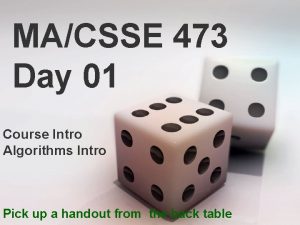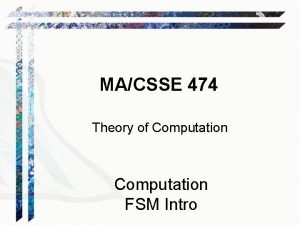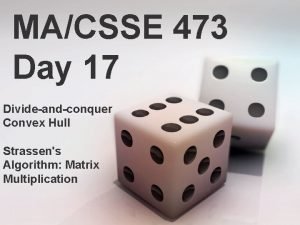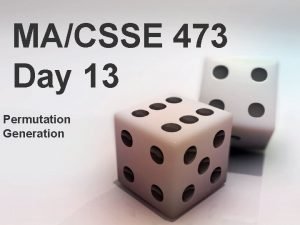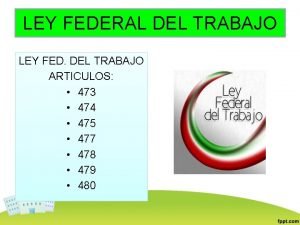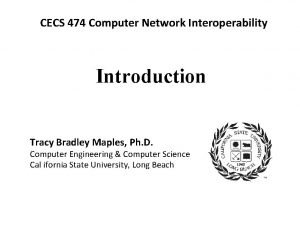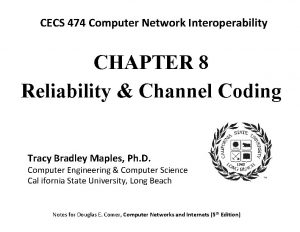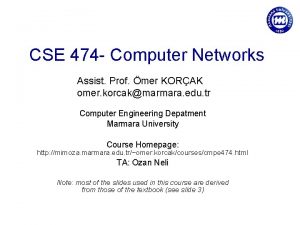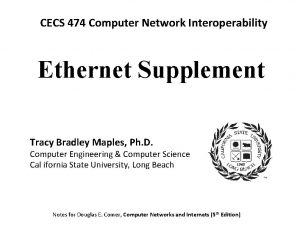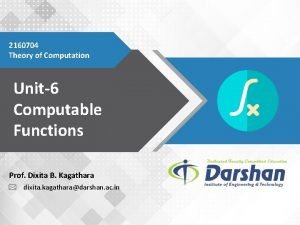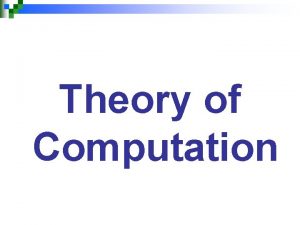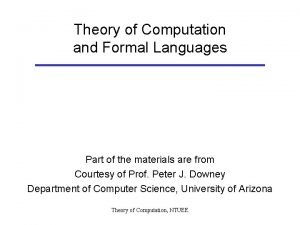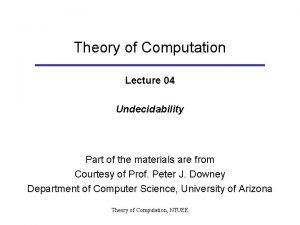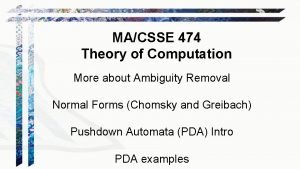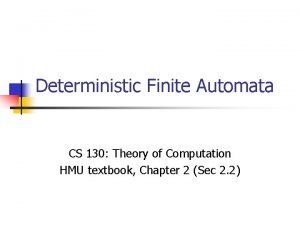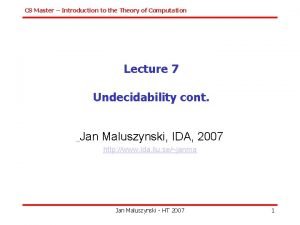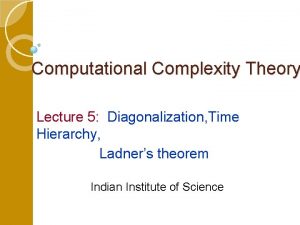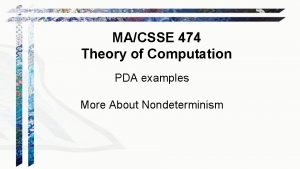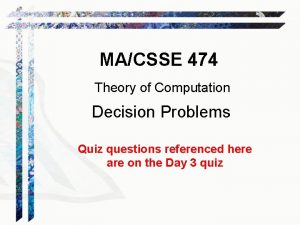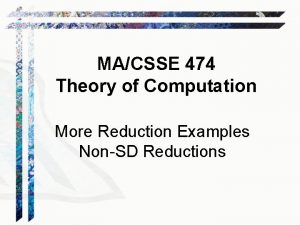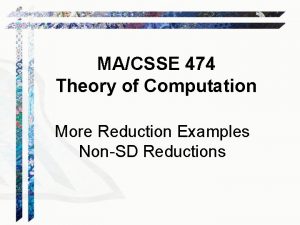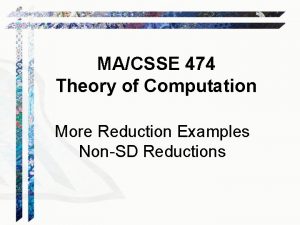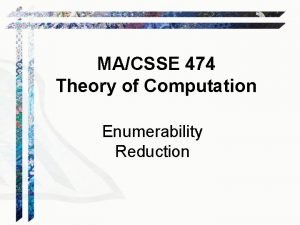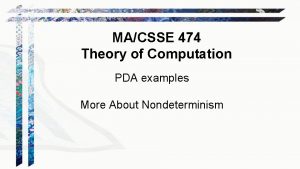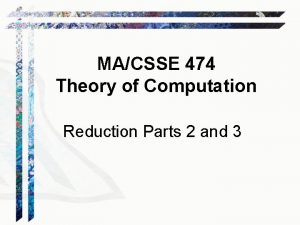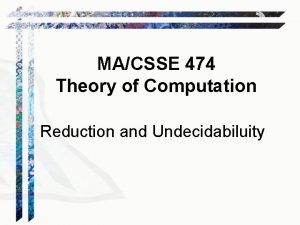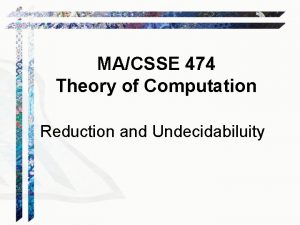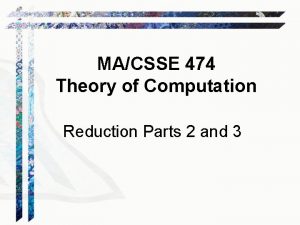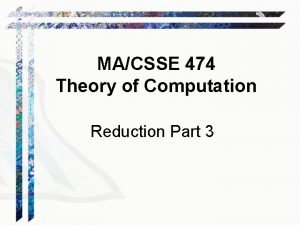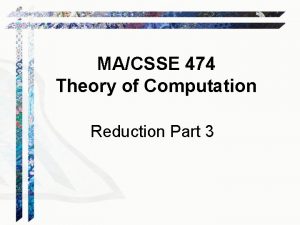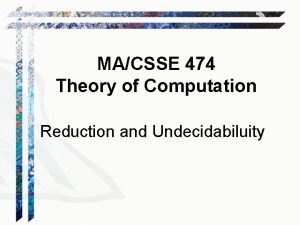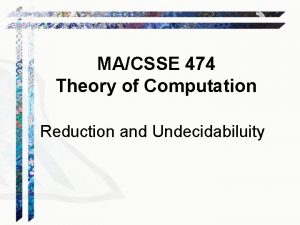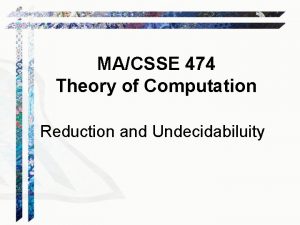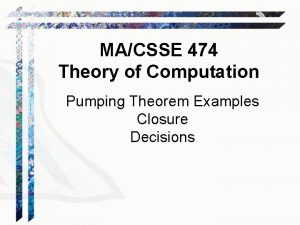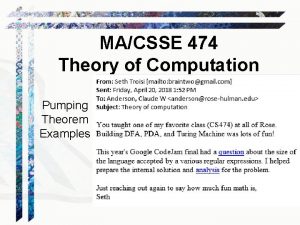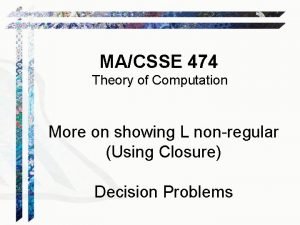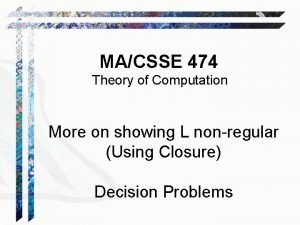MACSSE 474 Theory of Computation More Reduction Examples
























- Slides: 24

MA/CSSE 474 Theory of Computation More Reduction Examples Non-SD Reductions

Your Questions? • Previous class days' material • Reading Assignments • HW 15 problems • Final Exam • Anything else Excerpt from an obituary in the Terre Haute Tribune Star. May 12, 2018:

Reducing Language L 1 to L 2 • Language L 1 (over alphabet 1) is mapping reducible to language L 2 (over alphabet 2) and we write L 1 L 2 if there is a Turing-computable function f : 1* 2* such that x 1*, x L 1 if and only if f(x) L 2

Using Reduction for Undecidability (R is a reduction from L 1 to L 2) (L 2 is in D) (L 1 is in D) If (L 1 is in D) is false, then at least one of the two antecedents of that implication must be false. So: If (R is a reduction from L 1 to L 2) is true and (L 1 is in D) is false, then (L 2 is in D) must be false. Application: If L 1 is a language that is known to not be in D, and we can find a reduction from L 1 to L 2, then L 2 is also not in D.

Using Reduction for Undecidability Showing that L 2 is not in D: L 1 (known not to be in D) L 1 in D But L 1 not in D R L 2 (a new language whose if L 2 in D decidability we are trying to determine) L 2 not in D

To Show L 2 undecidable 1. Choose a language L 1 that is already known not to be in D, A. Assume a TM Oracle that decides L 2 B. show that L 1 can be reduced to L 2 Details: 2. Define the reduction R. 3. Describe the composition C of R with Oracle. 4. Show that C correctly decides L 1 iff Oracle exists. We do this by showing: ● R can be implemented by Turing machines, ● C is correct: ● If x L 1, then C(x) accepts, and Follow this outline in ● If x L 1, then C(x) rejects. proofs that you submit. . First Reduction Example: H = {<M> : TM M halts on } We will see many examples in the next few sessions.

show H in SD but not in D 1. H is in SD. T semidecides it: T(<M>) = 1. Run M on . 2. Accept. T accepts <M> iff M halts on , so T semidecides H . * Recall: "M halts on w" is a short way of saying "M, when started with input w, eventually halts"

H = {<M> : TM M halts on } 2. Theorem: H = {<M> : TM M halts on } is not in D. Proof: by reduction from H to H : H ≤ H is intuitive, the other direction is not so obvious. H = {<M, w> : TM M halts on input string w} R (? Oracle) H {<M> : TM M halts on } R is a reduction from H to H : R(<M, w>) = 1. Construct <M#>, where M#(x) operates as follows: 1. 1. Erase the tape. 1. 2. Write w on the tape and move the head to the left end. 1. 3. Run M on w. 2. Return <M#>.

Proof, Continued R(<M, w>) = 1. Construct <M#>, where M#(x) operates as follows: 1. 1. Erase the tape. 1. 2. Write w on the tape and move the head to the left end. 1. 3. Run M on w. 2. Return <M#>. If Oracle exists, C = Oracle(R(<M, w>)) decides H: ● C is correct: M# ignores its own input. It halts on every input or no inputs. So there are two cases: ● <M, w> H: M halts on w, so M# halts on everything. In particular, it halts on . Oracle accepts. ● <M, w> H: M does not halt on w, so M# halts on nothing and thus not on . Oracle rejects.

A Block Diagram of C Note: In the last two places where M# appears in this diagram, it should be <M#>

R Can Be Implemented as a Turing Machine R must construct <M#> from <M, w>. Suppose w = aba. M# will be: So the procedure for constructing M# is: 1. Write: 2. For each character x in w do: 2. 1. Write x. 2. 2. If x is not the last character in w, write R. 3. Write Lq M.

Conclusion R can be implemented as a Turing machine. C is correct. So, if Oracle exists: C = Oracle(R(<M, w>)) decides H. But no machine to decide H can exist. So neither does Oracle.

This Result is Somewhat Surprising If we could decide whether M halts on the specific string , we could solve the more general problem of deciding whether M halts on an arbitrary input. Clearly, the other way around is true: If we could solve H we could decide whether M halts on any one particular string. But we used reduction to show that H undecidable implies H undecidable; this is not at all obvious.

Different Languages Are We Dealing With? H = {<M, w> : TM M halts on input string w} R (? Oracle) H {<M> : TM M halts on } H contains strings of the form: (q 00, a 00, q 01, a 10, ), …, aaa H contains strings of the form: (q 00, a 00, q 01, a 10, ), … The language on which some M halts contains strings of some arbitrary form, for example, (letting = {a, b}): aaaba

Different Machines Are We Dealing With? H = {<M, w> : TM M halts on input string w} R (? Oracle) H {<M> : TM M halts on } R is a reduction from H to H : R(<M, w>) = 1. Construct <M#>, where M#(x) operates as follows: 1. 1. Erase the tape. 1. 2. Write w on the tape. 1. 3. Run M on w. 2. Return <M#>. ● Oracle (the hypothesized machine to decide H ). ● R (the machine that builds M#. Actually exists). ● C (the composition of R with Oracle). ● M# (the machine we will pass as input to Oracle). Note that we never run it. ● M (the machine with an encoding whose membership in H we are interested in determining; thus also an input to R).

A Block Diagram of C Note: In the last twoplaces where M# appears in this diagram, it should be <M#>

Another Way to View the Reduction // let L = {<M> | M is a TM that halts when its input is epsilon} // if L is decidable, let the following function decide L: boolean halts. On. Epsilon(TM M); // defined in magic. h // Halts. On decides H using Halts. On. Epsilon //. : Halts. On reduces to Halts. On. Epsilon: bool halts. On(TM M, string w) { void wrapper(string i. Dont. Care) {// a nested TM M(w); } {// end of nested TM return halts. On. Epsilon(wrapper); } If Halts. On. Epsilon is a decision procedure, so is Halts. On. But of course Halts. On is not, so neither is Halts. On. Epslipn

Important Elements in a Reduction Proof • A clear declaration of the reduction “from” and “to” languages. • A clear description of R. • If R is doing anything nontrivial, argue that it can be implemented as a TM. • Note that machine diagrams are not necessary or even sufficient in these proofs. Use them as thought devices, where needed. • Run through the logic that demonstrates how the “from” language is being decided by the composition of R and Oracle. You must do both accepting and rejecting cases. • Declare that the reduction proves that your “to” language is not in D.

The Most Common Mistake: Doing the Reduction Backwards The right way to use reduction to show that L 2 is not in D: 1. Given that L 1 is not in D, 2. Reduce L 1 to L 2, i. e. , show to solve L 1 (the known one) in terms of L 2 (the unknown one) L 1 L 2 Doing it wrong by reducing L 2 (the unknown one) to L 1: If there exists a machine M 1 that solves H, then we could build a machine that solves L 2 as follows: 1. Return (M 1(<M, >)). This proves nothing. It’s an argument of the form: If False then …

Next Example: HANY = {<M> : there exists at least one string on which TM M halts} Theorem: HANY is in SD. Proof: by exhibiting a TM T that semidecides it. What about simply trying all the strings in * one at a time until one halts?

HANY is in SD T(<M>) = 1. Use dovetailing* to try M on all of the elements of *: [1] [2] [3] [4] [5] a a [1] [2] b [1] [3] b [2] aa [1] [4] b [3] aa [2] ab [1] 2. If any instance of M halts, halt and accept. T will accept iff M halts on at least one string. So T semidecides HANY. * http: //en. wikipedia. org/wiki/Dovetailing_(computer_science)

HANY is not in D

The Steps in a Reduction Proof 1. Choose an undecidable language to reduce from. 2. Define the reduction R. 3. Show that C (the composition of R with Oracle) is correct. indicates where we make choices.

Undecidable Problems (Languages That Aren’t In D) The Problem View The Language View Does TM M halt on w? H = {<M, w> : M halts on w} Does TM M not halt on w? H = {<M, w> : M does not halt on w} Does TM M halt on the empty tape? H = {<M> : M halts on } Is there any string on which TM M halts? HANY = {<M> : there exists at least one string on which TM M halts } Does TM M accept all strings? AALL = {<M> : L(M) = *} Do TMs Ma and Mb accept the same languages? Eq. TMs = {<Ma, Mb> : L(Ma) = L(Mb)} Is the language that TM M accepts regular? TMreg = {<M>: L(M) is regular} Next: We examine proofs of some of these (some are also done in the textbook)
 Lirik lagu more more more we praise you
Lirik lagu more more more we praise you More more more i want more more more more we praise you
More more more i want more more more more we praise you Macsse
Macsse Macsse
Macsse Strassens algorithm
Strassens algorithm Macsse
Macsse Ley federal del trbajo
Ley federal del trbajo Cecs 474
Cecs 474 Topology in computer network
Topology in computer network Cse 474
Cse 474 Cecs 474
Cecs 474 Art 474 lft
Art 474 lft Instinct theory
Instinct theory Union set operation
Union set operation 2160704
2160704 Generalized transition graph
Generalized transition graph Theory of computation
Theory of computation Theory of computation
Theory of computation Ambiguity
Ambiguity Theory of computation
Theory of computation Is etm recognizable
Is etm recognizable Time complexity hierarchy
Time complexity hierarchy Anbncn pda
Anbncn pda Theory of computation quiz
Theory of computation quiz Theory of computation
Theory of computation


